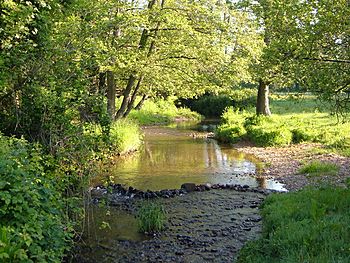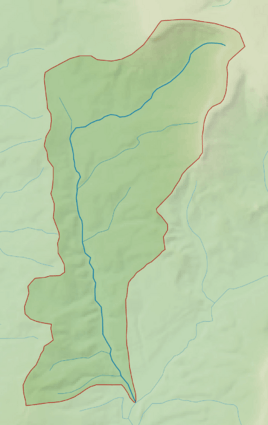River Tale facts for kids
Quick facts for kids River Tale |
|
|---|---|

River Tale near Cadhay
|
|

Catchment map of the River Tale
|
|
|
Location within Devon
|
|
| Country | England |
| County | Devon |
| Physical characteristics | |
| Main source | Broadhembury |
| River mouth | River Otter, Devon Devon 50°45′22″N 3°17′17″W / 50.7562°N 3.2880°W |
| Length | 14.2 km (8.8 mi) |
The River Tale is a small river in Devon, England. It flows down the southern side of the Blackdown Hills. It's a branch, or 'tributary,' of the River Otter. The River Tale is about 14.2 kilometers (8.8 miles) long.
Its name comes from an old English word, getæl, which means 'quick' or 'swift'. However, the river is actually known for being quite slow. Some people think its name might have come from Tala Water, another river nearby. The River Tale is also a special place where people are trying to bring back water voles. These small animals were thought to have disappeared from Devon.
Where the River Tale Flows
The River Tale starts high up on the southern slopes of the Blackdown Hills, near a place called North Hill. From there, it flows southwest through the village of Broadhembury. It then goes under the A373 road.
The river then turns south and flows past the beautiful grounds of Escot House. It continues through Fairmile, where it crosses under the A30 road. Finally, the River Tale joins the River Otter at Cadhay, close to Ottery St Mary.
River Flow and Water Levels
Since 1978, scientists have been measuring the water levels and how fast the River Tale flows. They do this in the lower part of the river, near Fairmile. The area of land that drains water into the river, called its catchment area, is about 34 square kilometers (13 square miles).
On average, the river flows at about 0.44 cubic meters per second. This is like saying that nearly half a cubic meter of water passes by every second. The highest water level ever recorded was in December 1981. The water reached a height of 1.72 meters (5.6 feet), and the river was flowing very fast, at 19.56 cubic meters per second.
The land around the river mostly has farms with crops and grass. The river's flow is natural, meaning it's not changed by human-made things like dams.
River Animals and Plants
The River Tale's water quality is rated as 'moderate' under something called the Water Framework Directive. This is a system that checks how healthy rivers are. While 'moderate' is in the middle, the chemical quality of the water was considered 'good' in 2014.
One important animal that used to live in Devon's rivers is the water vole (Arvicola amphibius). By the year 2000, these small creatures were thought to be gone from the rivers in Devon. This happened because they lost their homes and were hunted by American mink (Neovison vison), which are not native to the area.
In 2004, the River Tale was chosen as a place to bring water voles back. This was part of a project to make the river a better home for them. They put up fences to stop cows from damaging the plants along the riverbanks. They also set traps for mink. Since these improvements, there are more fish in the river. Also, otters (Lutra lutra), which are another type of river animal, have started to come back to the River Tale.


